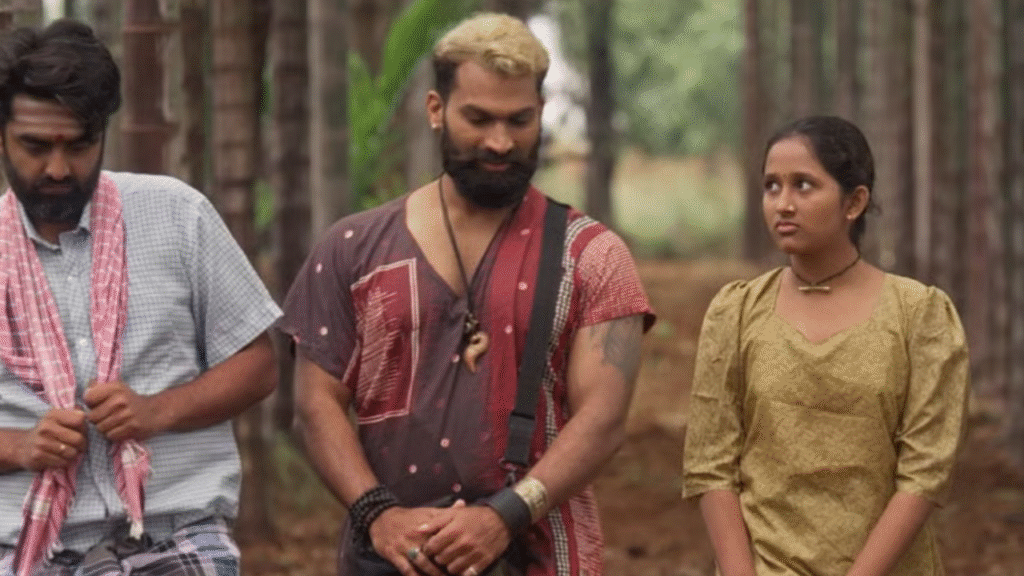Language: Kannada
Genre: Drama, Anthology, Philosophical Fiction
Age Rating: U/A
Amidst a world of fast-paced narratives and overstimulated storytelling, Sees Kaddi walks a quieter path. Rooted in Kannada culture and philosophical depth, this emotionally layered film explores storytelling not as a linear plot, but as a reflection of self-discovery, loss, and longing. Anchored by a writer’s internal conflict and shaped through interactions with a former harikatha performer turned security guard, Sees Kaddi transforms into a cinematic canvas painted with memories, musings, and myth-inspired metaphors.
Plot: Stories That Reflect Life and Heal the Soul
Sees Kaddi begins with a writer locked in a mental struggle, weighed down by creative fatigue and personal uncertainties. One casual conversation with the apartment’s security guard—a man with a past in traditional storytelling—sparks a chain of narratives that subtly mirror the writer’s own dilemmas.
In a creative twist on the Vikram-Betaal legend, the writer becomes Vikrama, the narrator, and the guard becomes Betaal, the silent receiver and emotional anchor. As Vikrama begins narrating different stories—each disconnected on the surface but deeply intertwined at the core—he starts resolving his inner turbulence.
Check Out: Puppy (2025) Kannada Movie Review – A Sincere Tale That Touches, But Doesn’t Fully Grip
Interwoven Stories: Tales of Heart, Hope, and Humanity
The film unfolds like a thoughtful anthology, with each segment immersing us into a new world:
- Raveesha’s Tale is a nostalgic return to childhood and simplicity, as a village boy resists the pressures of urban migration. His bond with his teacher, grandparents, and school speaks volumes about roots and identity.
- The Nameless Girl, who carves her sense of self through music and an inspiring bond with a mute tabla artist, reminds us that names don’t define people—actions do.
- Fareed’s Episode touches on fleeting inspiration as a tea vendor girl, caring for her ailing father, unknowingly becomes a muse to a wandering writer.
- Toufiq’s Story is perhaps the most charming, with a young cinema lover offering payment based on how much a film moves him. His innocence and honest criticism turn into guidance for a struggling filmmaker.
Each tale is packed with emotion, culture, and a quiet sense of awakening, making the entire film feel like a visual diary of real people in fictional forms.
What Works Beautifully
✅ Unique Storytelling Format – The Vikrama-Betaal metaphor reimagined as a literary device is creative and reflective.
✅ Grounded Performances – Characters feel lived-in, performed with sincerity and emotional restraint.
✅ Cultural Resonance – Rooted in Kannada traditions and rural aesthetics, the film retains a strong local flavor.
✅ Subtle Music and Lyrics – The soundtrack complements each narrative without overwhelming the emotion.
✅ Visual Poise – Soothing frames, warm tones, and minimalistic storytelling create a meditative pace.
What Doesn’t Work
The film’s biggest strength—its anthology format and philosophical depth—can also feel like a weakness to some viewers. The first half struggles with narrative cohesion, as multiple storylines unfold without clear connections. For those accustomed to fast-moving plots or intense drama, the film’s quiet tone might feel slow or even meandering. At times, the film is dense with ideas, which can become emotionally overwhelming if not fully absorbed.
Check Out: Maadeva Movie Review – A Powerful Action Drama Rooted in Grit and Emotion
Direction, Tone & Craftsmanship
Without relying on visual grandeur or dramatic twists, the director (unnamed in credits) builds an experience that unfolds more like a conversation than a performance. The transitions between stories and timelines are smooth, and the emotional flow feels consistent. Dialogue is minimalistic, sometimes even poetic, allowing silences to speak as powerfully as the words.
Themes: Identity, Loneliness and the Power of Listening
- Loneliness vs Imagination – The film asks a beautiful question: Can a writer ever be truly lonely when they live among characters and tales in their mind?
- Cultural Continuity – From harikatha traditions to modern dilemmas, Sees Kaddi beautifully bridges the past and present.
- Everyday Wisdom – Whether it’s a child’s honest opinion or an elder’s silence, wisdom flows through the film in unexpected ways.
Final Verdict: ⭐⭐⭐⭐ (4/5 Stars)
Sees Kaddi is a meditative, lyrical journey through memory, culture, and self-awareness. While it may not offer the instant gratification of mainstream cinema, its strength lies in its quiet confidence. With emotionally resonant tales, grounded characters, and a sense of timelessness, this Kannada gem speaks to the soul—if you’re willing to listen.
Should You Watch It?
Yes, if you appreciate slow cinema that nudges you into thought rather than dragging you through plot twists. Sees Kaddi is for those who enjoy reflection, character-driven storytelling, and the comfort of narratives that feel like bedtime stories for grown-ups. It’s a film that lingers—like a good book, a gentle conversation, or a distant memory revisited.

